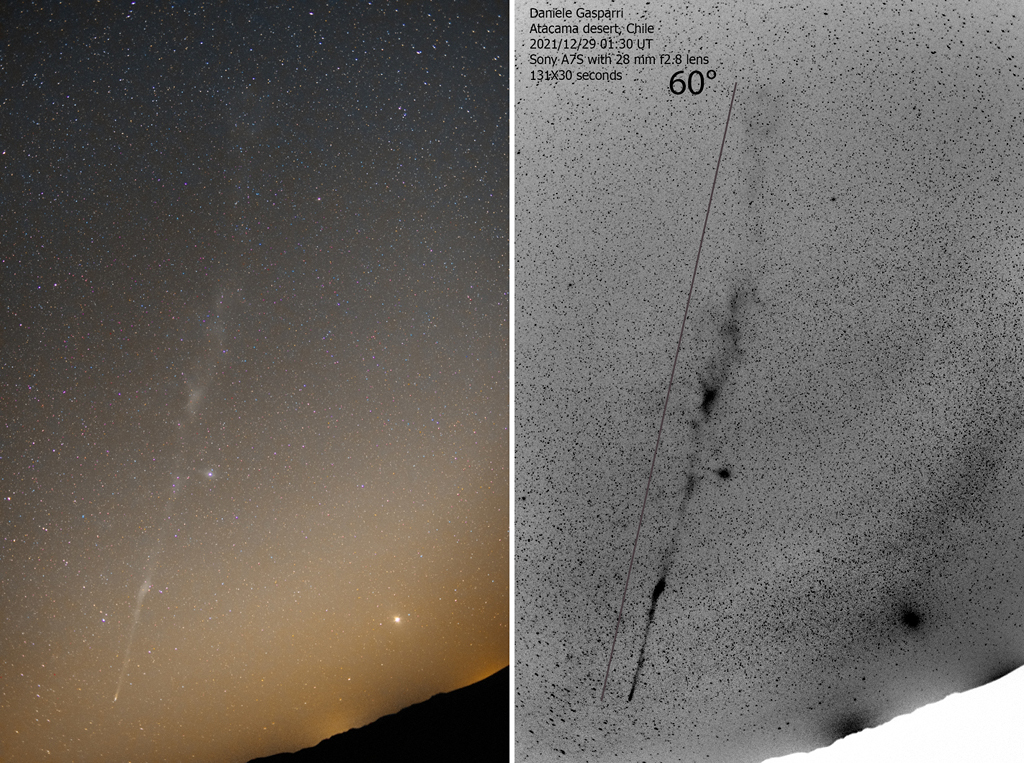30. December 2021
Leonard 彗星 ê 長尾溜

探索宇宙1!逐工會揀一幅無仝款 ê 影像抑是相片,𤆬你熟似咱這个迷人 ê 宇宙,閣有專業天文學者2為你解說3。
- 原始文章:The Further Tail of Comet Leonard
- 影像來源 kah 版權:Daniele Gasparri
- 台文翻譯:An-Li Tsai (NCU)
[漢羅] Leonard 彗星 ê 長尾溜
Leonard 彗星 是 2021 年上光 ê 彗星。 這兩張相片是 tī 智利 Atacama 沙漠 ê 天頂翕 ê,彗星 to̍h tī 這兩張相片 ê 倒爿下跤遐。 一月 3 號是 Leonard 彗星 ê 近日點,伊這馬當 leh 飛過去,彗尾嘛愈來愈長,愈來愈看會著。 這是 kā 闊幅鏡頭翕 ê 幾若張相片疊做一張 ê(用烏白相片是欲予這个對比閣較明顯)。 按呢翕,是為著欲追蹤複雜 ê 離子尾溜。 是講,這个尾溜迒過天頂 60 度闊,實在是有夠長 ê 啦! 木星嘛足光 ê,tī 正爿下跤 ê 地平線附近爍咧爍咧。 這款物質是 ùi Leonard 彗星 ê 核心 蒸發出來 ê。 這差不多有 1 公里闊,內底有足濟沙塗、岩石、kah 冰。 這寡物件去予太陽光照甲面頂 ê 離子氣體 leh 發光,產生長長 ê 尾溜。 最近幾若禮拜 彗核 受著太陽風 kah 磁場 ê 影響,有當時仔會突然間爍一下。 這嘛造成彗尾產生無規則、彎彎曲曲 ê 尾溜。 Leonard 彗星到近日點猶閣有幾若工,伊會繼續 遮爾活跳跳。 彗星這馬 tī 太陽系黃道面 ê 南爿,掃過南天 ê 顯微鏡座。
[POJ] Leonard Hui-chhiⁿ ê tn̂g-bóe-liu
Leonard hui-chhiⁿ sī jī-khòng-jī-it nî siōng-kng ê hui-chhiⁿ. Chi̍t-nn̄g-tiuⁿ siòng-phìⁿ sī tī Tì-lī Atacama soa-bo̍k ê thiⁿ-téng hip ê, hui-chhiⁿ to̍h tī chit-nn̄g-tiuⁿ siòng-phìⁿ ê tò-pêng ē-kha. It-goe̍h saⁿ hō sī Leonard hui-chhiⁿ ê kīn-ji̍t-tiám, i chit-má tng-leh poe–kòe-khì, hūi-bóe mā lú-lâi lú-tn̂g, lú-lâi lú khòaⁿ-ē-tio̍h. Che sī kā khoah-pak kiàⁿ-thâu hip ê kúi-ā-tiuⁿ siòng-phìⁿ tha̍h-chò chi̍t-tiuⁿ ê (iōng o͘-pe̍h siòng-phìⁿ sī beh hō͘ chit-ê tùi-pí koh-khah bêng-hián). Án-ne hip, sī ūi-tio̍h beh tui-chong ho̍k-cha̍p ê lî-chú bóe-liu. Sī-kóng, chit-ê bóe-liu hāⁿ-kòe thiⁿ-téng la̍k-cha̍p tō͘ khoah, si̍t-chāi sī ū-kàu tn̂g ê lah! Bo̍k-chhiⁿ mā chiok-kng ê, tī chiàⁿ-pêng ē-kha ê tē-pêng-sòaⁿ hū-kīn sih-leh-sih-leh. Chit-khoán bu̍t-chit sī ùi Leonard hui-chhiⁿ ê he̍k-sim cheng-hoat chhut-lâi ê. Che chha-put-to ū chi̍t kong-lí khoah, lāi-té ū chiok-chōe soa-thô͘, giâm-chio̍h, kah peng. Chit-kóa mi̍h-kiāⁿ khì hō͘ thài-iông-kng chiò kah bīn-téng ê lî-chú khì-thé leh hoat-kng, sán-seng tn̂g-tn̂g ê bóe-liu. Chòe-kīn kúi-ā lé-pài hūi-he̍k siū-tio̍h thài-iông-hong kah chû-tiûⁿ ê éng-hióng, ū-tang-sî-á ē tu̍t-jiân-kan sih chi̍t-ê. Che mā chō-sêng hūi-bóe sán-seng bô-kui-chek, oan-oan-khiau-khiau ê bóe-liu. Leonard hui-chhiⁿ kàu kīn-ji̍t-tiám iáu koh-ū kúi-ā-kang, i ē kè-sio̍k chiah-nī oa̍h-thiàu-thiàu. Hui-chhiⁿ chit-má tī Thài-iông-hē n̂g-tō-bīn ê lâm-pêng, sàu-kòe lâm-thian ê Hián-bî-kiàⁿ-chō.
[KIP] Leonard Hui-tshinn ê tn̂g-bué-liu
Leonard hui-tshinn sī jī-khòng-jī-it nî siōng-kng ê hui-tshinn. Tsi̍t-nn̄g-tiunn siòng-phìnn sī tī Tì-lī Atacama sua-bo̍k ê thinn-tíng hip ê, hui-tshinn to̍h tī tsit-nn̄g-tiunn siòng-phìnn ê tò-pîng ē-kha. It-gue̍h sann hō sī Leonard hui-tshinn ê kīn-ji̍t-tiám, i tsit-má tng-leh pue–kuè-khì, huī-bué mā lú-lâi lú-tn̂g, lú-lâi lú khuànn-ē-tio̍h. Tse sī kā khuah-pak kiànn-thâu hip ê kuí-ā-tiunn siòng-phìnn tha̍h-tsò tsi̍t-tiunn ê (iōng oo-pe̍h siòng-phìnn sī beh hōo tsit-ê tuì-pí koh-khah bîng-hián). Án-ne hip, sī uī-tio̍h beh tui-tsong ho̍k-tsa̍p ê lî-tsú bué-liu. Sī-kóng, tsit-ê bué-liu hānn-kuè thinn-tíng la̍k-tsa̍p tōo khuah, si̍t-tsāi sī ū-kàu tn̂g ê lah! Bo̍k-tshinn mā tsiok-kng ê, tī tsiànn-pîng ē-kha ê tē-pîng-suànn hū-kīn sih-leh-sih-leh. Tsit-khuán bu̍t-tsit sī uì Leonard hui-tshinn ê hi̍k-sim tsing-huat tshut-lâi ê. Tse tsha-put-to ū tsi̍t kong-lí khuah, lāi-té ū tsiok-tsuē sua-thôo, giâm-tsio̍h, kah ping. Tsit-kuá mi̍h-kiānn khì hōo thài-iông-kng tsiò kah bīn-tíng ê lî-tsú khì-thé leh huat-kng, sán-sing tn̂g-tn̂g ê bué-liu. Tsuè-kīn kuí-ā lé-pài huī-hi̍k siū-tio̍h thài-iông-hong kah tsû-tiûnn ê íng-hióng, ū-tang-sî-á ē tu̍t-jiân-kan sih tsi̍t-ê. Tse mā tsō-sîng huī-bué sán-sing bô-kui-tsik, uan-uan-khiau-khiau ê bué-liu. Leonard hui-tshinn kàu kīn-ji̍t-tiám iáu koh-ū kuí-ā-kang, i ē kè-sio̍k tsiah-nī ua̍h-thiàu-thiàu. Hui-tshinn tsit-má tī Thài-iông-hē n̂g-tō-bīn ê lâm-pîng, sàu-kuè lâm-thian ê Hián-bî-kiànn-tsō.
[English] The Further Tail of Comet Leonard
Comet Leonard, brightest comet of 2021, is at the lower left of these two panels captured on December 29 in dark Atacama desert skies. Heading for its perihelion on January 3 Comet Leonard’s visible tail has grown. Stacked exposures with a wide angle lens (also displayed in a reversed B/W scheme for contrast), trace the complicated ion tail for an amazing 60 degrees, with bright Jupiter shining near the horizon at lower right. Material vaporizing from Comet Leonard’s nucleus, a mass of dust, rock, and ices about 1 kilometer across, has produced the long tail of ionized gas fluorescing in the sunlight. Likely flares on the comet’s nucleus and buffeting by magnetic fields and the solar wind in recent weeks have resulted in the tail’s irregular pinched and twisted appearance. Still days from its closest approach to the Sun, Comet Leonard’s activity should continue. The comet is south of the Solar System’s ecliptic plane as it sweeps through the southern constellation Microscopium.
詞彙學習(漢羅/POJ/KIP/華語/English)
- 【闊幅鏡頭】khoah-pak kiàⁿ-thâu/khuah-pak kiànn-thâu/廣角鏡頭/wide angle lens
- 【近日點】kīn-ji̍t-tiám/kīn-ji̍t-tiám/近日點/perihelion
- 【彗尾】hūi-bóe/huī-bué/彗尾/comet’s tail
- 【彗核】hūi-he̍k/huī-hi̍k/彗核/comet’s nucleus
- 【黃道面】n̂g-tō-bīn/n̂g-tō-bīn/黃道面/ecliptic plane
- 【顯微鏡座】Hián-bî-kiàⁿ-chō/Hián-bî-kiànn-tsō/顯微鏡座/Microscopium
- 【太陽風】thài-iông-hong/thài-iông-hong/太陽風/solar wind
- 【磁場】chû-tiûⁿ/tsû-tiûnn/磁場/magnetic field